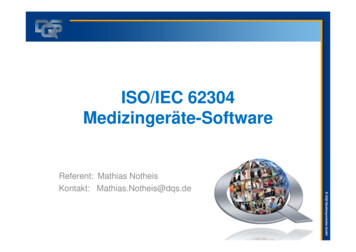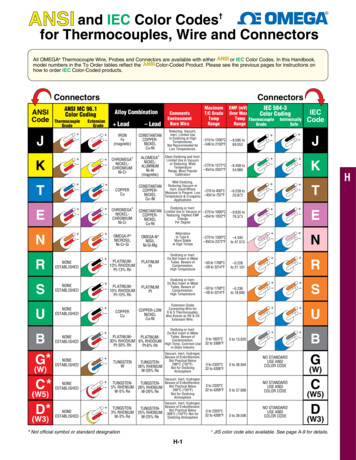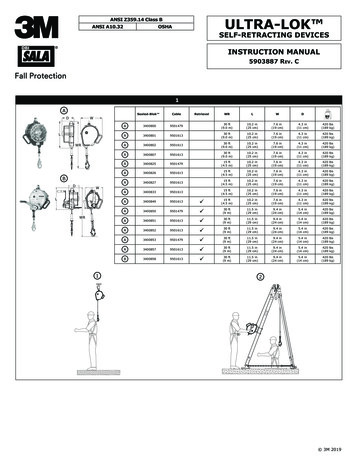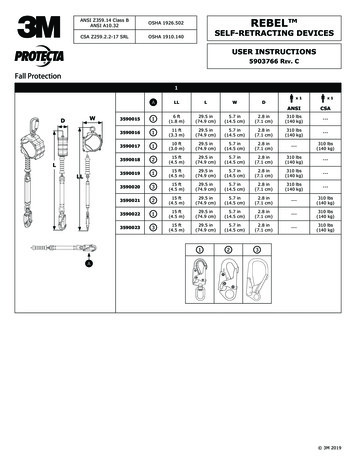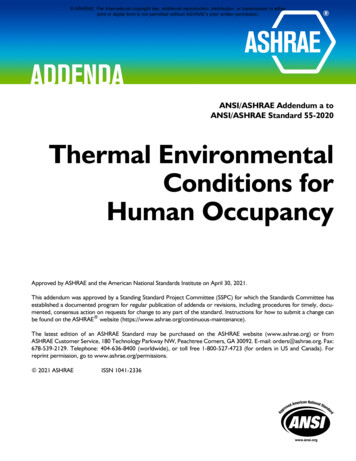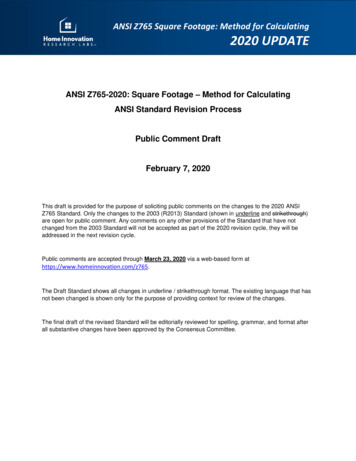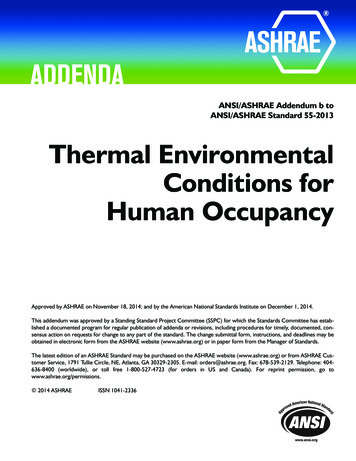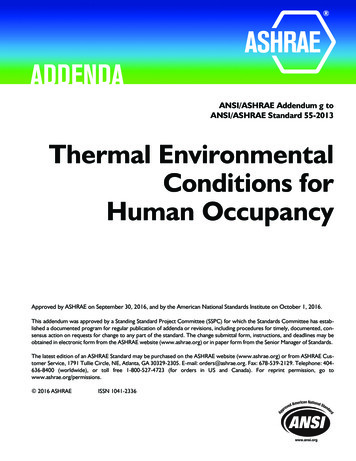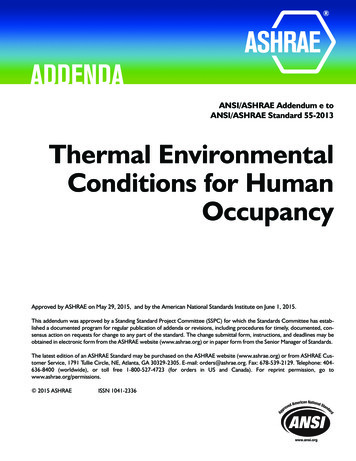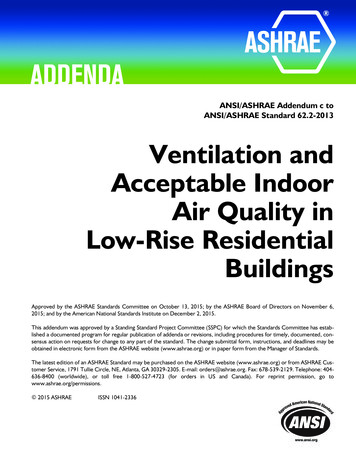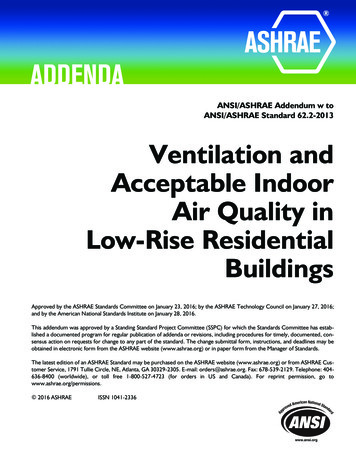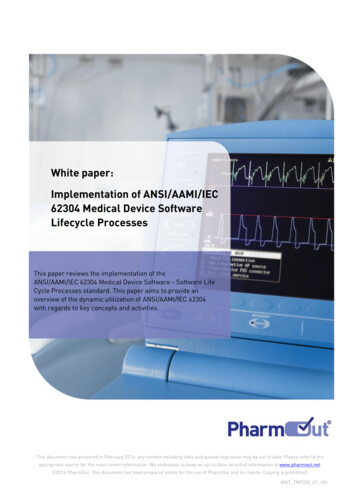
Transcription
White paper:Implementation of ANSI/AAMI/IEC62304 Medical Device SoftwareLifecycle ProcessesThis paper reviews the implementation of theANSI/AAMI/IEC 62304 Medical Device Software - Software LifeCycle Processes standard. This paper aims to provide anoverview of the dynamic utilization of ANSI/AAMI/IEC 62304with regards to key concepts and activities.This document was prepared in February 2016, any content including links and quoted regulation may be out of date. Please refer to theappropriate source for the most recent information. We endeavour to keep an up-to-date record of information at www.pharmout.net. 2016 PharmOut. This document has been prepared solely for the use of PharmOut and its clients. Copying is prohibited.MKT TMP200 01 r06
PharmOut white paper:Implementation of ANSI/AAMI/IEC 62304 Medical Device Software Lifecycle ProcessesPrerequisitesThe list below provides prerequisites for the users of the Technical Paper: Availability of ANSI/AAMI/IEC 62304 Familiarity with ANSI/AAMI/IEC 62304 General Knowledge of project management, systems development processes andsystem life cycle models.Scope of the ANSI/AAMI/IEC 62304ANSI/AAMI/IEC 62304 Standard applies to the development and maintenance of medical devicesoftware where the software itself is a medical device or when the software is an embedded orintegral part of the final medical device.The standard does not cover testing, validation and final release of the medical device, evenwhen the device consists entirely of software.This paper does not detail the maintenance activities of the medical devices because theactivities and processes are similar to the software development concept.Context of the ANSI/AAMI/IEC 62304An organization needs to be able to conduct business and perform operations. Standardsfacilitate businesses by providing a common framework for establishing agreements betweensystems acquirers and suppliers with respect to developing, using and managing a systemwithin the defined life cycle of that system.The ANSI/AAMI/IEC 62304 standard is applicable to organizations, enterprises and projectswhether they act as the acquirer or the supplier of a system.The standard defines the life cycle requirements for medical device software. It definesconceptual structure spanning the life of the software from the definition of its requirements tomanufacturing, which: Identifies the Processes, Activities and Tasks involved in development of aSoftware Describes the sequence of the dependency between activities and tasks, and Identifies the milestones at which the completeness of specified deliverables isverified.The software development process is divided into a set of activities, with most activities furtherdivided into a set of tasks. These activities are listed below: Software Development Planning Software Requirement Analysis Software Architectural DesignPharmOut Pty Ltd, ABN: 85 117 673 766, Unit 10, 24 Lakeside Drive, Burwood East, Victoria 3151.Ph: 61 3 9887 6412, Fax: 61 3 8610 0169, Email: info@pharmout.net Web: www.pharmout.net 2016 PharmOut. This document has been prepared solely for the use of PharmOut and its clients. Copying is prohibited.Page 2 of 15MKT TMP200 01 r06
PharmOut white paper:Implementation of ANSI/AAMI/IEC 62304 Medical Device Software Lifecycle Processes Software Detailed Design Software Unit Implementation &Verification Software Integration and Integration testing Software System Testing Software Release.The maintenance process activities are considered to be as important as the softwaredevelopment process activities. These activities include: Generate Software Maintenance Plan Problem and Modification AnalysisANSI/AAMI/IEC 62304 refers to the risk management process described in InternationalStandard ISO 14971 for identifying and managing risks during development and maintenance ofthe software.It is imperative to note that ANSI/AAMI/IEC 62304 recognizes two additional processesconsidered essential for developing safe medical software. They are the software configurationmanagement process and software problem resolution process.Compliance with the standard is accomplished by implementing all of the processes, activitiesand tasks identified in the standard in accordance with the software safety class.Software Safety ClassificationANSI/AAMI/IEC 62304 identifies three classes of medical device software in accordance with thepossible effects on patient, operator, or any other people affected by software-related hazards.The medical device software should be classified based on severity as follows: Class A: No injury or damage to health is possible Class B: Non-Serious injury is possible Class C: Death or Serious injury is possible.PharmOut Pty Ltd, ABN: 85 117 673 766, Unit 10, 24 Lakeside Drive, Burwood East, Victoria 3151.Ph: 61 3 9887 6412, Fax: 61 3 8610 0169, Email: info@pharmout.net Web: www.pharmout.net 2016 PharmOut. This document has been prepared solely for the use of PharmOut and its clients. Copying is prohibited.Page 3 of 15MKT TMP200 01 r06
PharmOut white paper:Implementation of ANSI/AAMI/IEC 62304 Medical Device Software Lifecycle ProcessesThe figure below illustrates the activities associated with each of three different classes of thesoftware.Figure 1 Classification of software and related activitiesUse of the StandardOverview A specific project can use the standard for developing and supporting a medicaldevice software. An organization can use the standard for managing one or more of the medicaldevice software’s life cycle stages. An organization can use the standard for developing the Quality ManagementSystem.Concept of useAn organization is driven by the nature of its business, corporate responsibilities and itsbusiness strategy.To help achieve the overall business and quality goals and exploit opportunities, an organizationshould establish policies and procedures to guide control and monitor the performance ofprojects and function groups.PharmOut Pty Ltd, ABN: 85 117 673 766, Unit 10, 24 Lakeside Drive, Burwood East, Victoria 3151.Ph: 61 3 9887 6412, Fax: 61 3 8610 0169, Email: info@pharmout.net Web: www.pharmout.net 2016 PharmOut. This document has been prepared solely for the use of PharmOut and its clients. Copying is prohibited.Page 4 of 15MKT TMP200 01 r06
PharmOut white paper:Implementation of ANSI/AAMI/IEC 62304 Medical Device Software Lifecycle ProcessesTo create these policies and procedures, and define the resources needed by the organization,the ANSI/AAMI/IEC 62304 standard can be utilized to provide specific standardized processesfor use within one or more software development life cycles.POLICY QUALITY STANDARDS ®ULATORY POLICY RISK MANAGEMENT POLICY SOFTWARE DEVELOPMENT POLICY PROJECT IMPLEMENTATIONPOLICY QUALITY POLICYNATURE OFBUSINESS DOMAIN OF PRODUCTS EXPERTISE AND SKILLS SOCIAL RESPONSIBILITIES REGULATORYCONSIDERATIONCONTROLS PROCEDURES WORK INSTRUCTIONS METHODS TEMPLATE TOOLSFigure 2 Overview of concept of useThe overall relationships between the various organizational activities are portrayed in Figure 2.The aim of the Quality Standard Policy is to define the standards and industry regulations thatthe organization adapts in order to achieve its organizational objectives which is reliant on thenature of business. The above figure also illustrates the factors that influence the nature ofbusiness.Similarly, the Risk Management, Project Implementation and Quality policies are used toensure that adequate assessment planning and control activities are utilized to create supportand monitor projects.At the initiation phases of the project to satisfy the stakeholder’s requirements, assessmentshould be conducted to identify if the current policies and procedures are sufficient.If the procedures and policies are not adequate, new ones are created or existing modifiedbased on the current standard in accordance with the scope, size and funding of the work to bedone.PharmOut Pty Ltd, ABN: 85 117 673 766, Unit 10, 24 Lakeside Drive, Burwood East, Victoria 3151.Ph: 61 3 9887 6412, Fax: 61 3 8610 0169, Email: info@pharmout.net Web: www.pharmout.net 2016 PharmOut. This document has been prepared solely for the use of PharmOut and its clients. Copying is prohibited.Page 5 of 15MKT TMP200 01 r06
PharmOut white paper:Implementation of ANSI/AAMI/IEC 62304 Medical Device Software Lifecycle ProcessesHow Does Standard-Driven Development Work Management defines expectations for how software is written and tested. Developers are trained on how the expectations relate to the business objectives. An automation infrastructure sits in the background of the developmentenvironment to automatically monitor compliance according to definedexpectations. For example, a policy may require all code to follow a designated setof secure development practices, undergo peer review, and be verified by testcases. When requirements are implemented, the automation infrastructure unobtrusivelyidentifies policy violations. If policy violations are identified, the infrastructure alerts the responsibledeveloper that policy violations need to be addressed immediately. The ability to passively and unobtrusively monitor developers' work is paramountto policy-driven development. If it is done properly, it will improve quality andincrease productivity.Consideration for UseThe ANSI/AAMI/IEC 62304 standard can be considered for a specific project with a set durationor for a continuous work effort conducted by an organization.The following are examples of items to consider while planning use of the ANSI/AAMI/IEC 62304standard.The scope of the work effort, such as: A single project or multiple projects within the organization. Concentration on some key processes or a single process where there is expectedto be some gain for the organization. Concentration on a single life cycle stage to carry out the operation of that stage.Identification and listing of stakeholders, such as: Intended users or customers of the medical device software. Other interested parties who have an interest or stake in the products. Sources of requirements and constraints.Desired outcomes, such as: Work products (software configuration item, or procedure document). Services or capabilities to be delivered or demonstrated at the end of the projectand at specific milestones.PharmOut Pty Ltd, ABN: 85 117 673 766, Unit 10, 24 Lakeside Drive, Burwood East, Victoria 3151.Ph: 61 3 9887 6412, Fax: 61 3 8610 0169, Email: info@pharmout.net Web: www.pharmout.net 2016 PharmOut. This document has been prepared solely for the use of PharmOut and its clients. Copying is prohibited.Page 6 of 15MKT TMP200 01 r06
PharmOut white paper:Implementation of ANSI/AAMI/IEC 62304 Medical Device Software Lifecycle ProcessesSpecial considerations, such as: Medical Device Software technologies that focus on hardware or humans. Medical Device Software classification including single use, repeated use andcontinuous use. Medical Device Software builds such as one-of-a-kind, replicated or massproduced.Goals and objectives of the project, such as: Specific objectives identified by milestones. Long-term utilization goals related to the use of the medical device software. Project strategy, such as: How the project will be carried out, including any agreement considerations. How work packages will be planned, assessed and controlled. How work products will be planned, evaluated and controlled. How work and changes will be authorized. Major milestone decision or event points (e.g. management reviews, meetings,pilot tests, deployments and deliveries) with milestone entry or exit criteria.Requirements and constraints, such as: Specific functional and performance requirements for, capabilities of or data froma Medical Device Software, including special quality attributes and usabilityexpectations or safety concerns. Policies, priorities and constraints such as risks, personnel, facilities, sites andcritical resources that will affect meeting the requirements and objectives of theproject. Core organizational technologies that will affect medical device softwarerequirements or other work product requirements and constraints; applicableorganizational processes, standards and specifications (including source andavailability); product implementation risks; and how information (includingdifferent product versions) will be captured, stored and controlled. Applicable medical device software life cycle stage activities (for exampledevelopment, pilot testing, full production) and expected outputs (for example.deliverables, work products and management reviews). Relevant stage entry or exit criteria, including expected level of medical devicesoftware maturity, level of acceptable risks and management review concerns. Project start-up and end dates, including milestone dates associated with approvaland progress reviews and pilot tests, as applicable. Management structure, including participants and their roles.PharmOut Pty Ltd, ABN: 85 117 673 766, Unit 10, 24 Lakeside Drive, Burwood East, Victoria 3151.Ph: 61 3 9887 6412, Fax: 61 3 8610 0169, Email: info@pharmout.net Web: www.pharmout.net 2016 PharmOut. This document has been prepared solely for the use of PharmOut and its clients. Copying is prohibited.Page 7 of 15MKT TMP200 01 r06
PharmOut white paper:Implementation of ANSI/AAMI/IEC 62304 Medical Device Software Lifecycle Processes Exclusions of organizations or persons (if applicable), including when the exclusionis or is not valid. Level of security classification and other security considerations, if applicable. Expected deliverables at milestones, at end of project/work and duringproject/work performance. Environment, recycling and reuse issues.AmendingWhen the ANSI/AAMI/IEC 62304 is used by an organization to form a set of policies andprocedures governing project work, amending the existing Quality Management System may bedone to appropriately reduce or extend the scope of the ANSI/AAMI/IEC 62
ANSI/AAMI/IEC 62304 refers to the risk management process described in International Standard ISO 14971 for identifying and managing risks during development and maintenance of the software. It is imperative to note that ANSI/AAMI/IEC 62304 recognizes two additional processes considered essential for developing safe medical software. They are the software configuration management process and .
